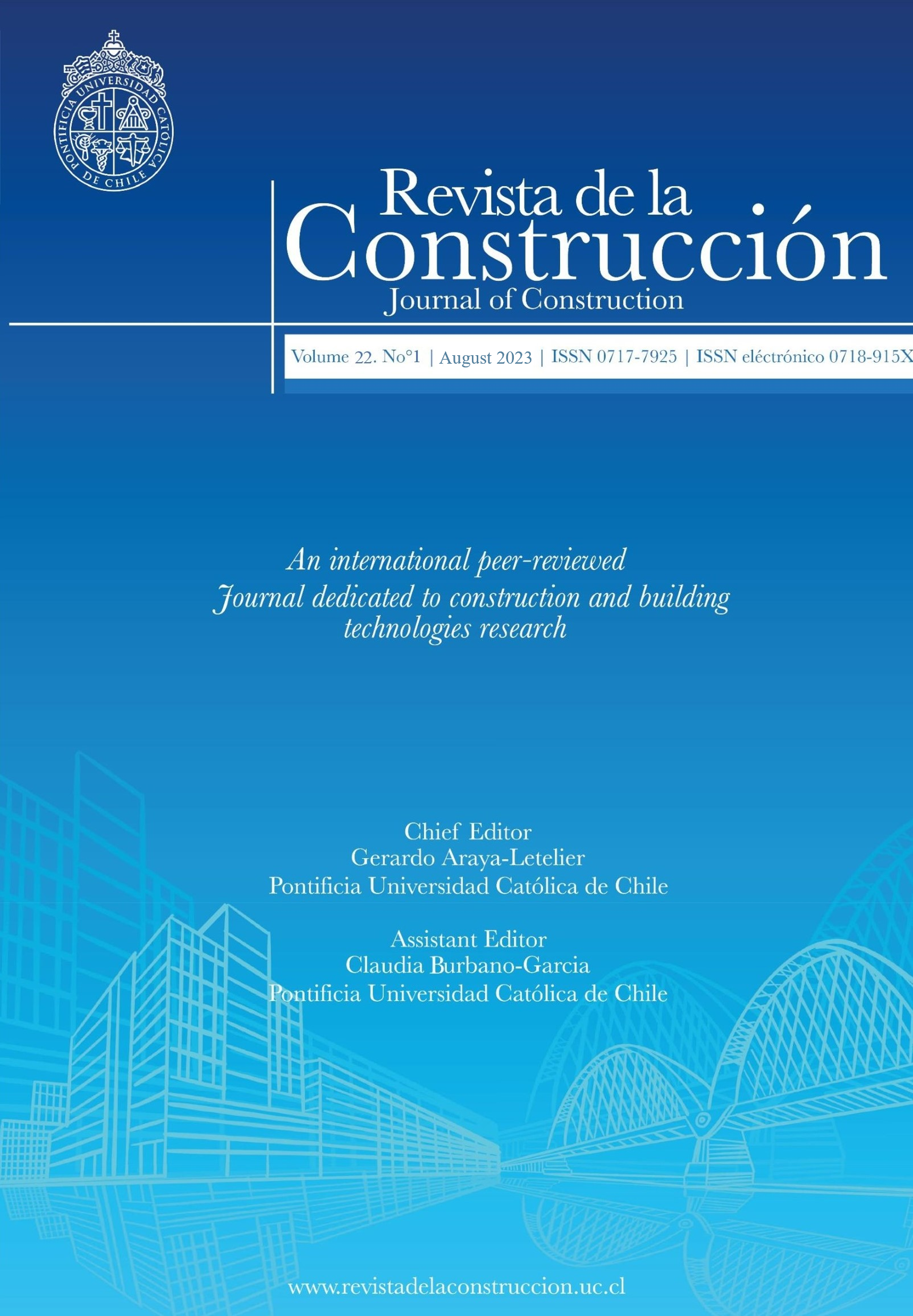Analytical investigation of the measures to be taken against weak storey irregularities
DOI:
https://doi.org/10.7764/RDLC.22.2.407Keywords:
weak storey, soft storey, RC wall, push-over analysis, irregularities of building.Abstract
Due to the earthquakes that have occurred in recent years, heavy damage has occurred in many structures in the world. When the damages occurred after the earthquakes have been examined, it has been observed that the damage occurred frequently in certain structures. These structures are generally structures with different shear capacity due to different story heights. This type of damage is defined as weak-soft storey irregularity in earthquake codes. For this reason, the use of reinforced concrete walls is recommended in the earthquake codes that have been updated in recent years. In addition, it is recommended by many researchers to strengthen the structures with various cross-frames on the storey where weak storey occur in such structures. For this purpose, a pushover analysis of structures with various storey heights and storey numbers supported by various cross-frames has been carried out. For this purpose, seismic analysis of 60 reinforced concrete structures has been made with the Seismo-Build program. In this study, the effectiveness of cross frames used in buildings with reinforced concrete wall and weak storey irregularities has been investigated.
Downloads
References
Abidi, M. (2012). Review on shear wall for soft story high-rise buildings. International Journal of Engineering and Advanced Technology (IJEAT), 6(1), 52-54. Alhazmi, T., & McCaffer, R. (2000). Project procurement system selection model. Journal of Construction Engineering and Management, 126(3), 176-184.
Agha Beigi, H., Christopoulos, C., Sullivan, T., & Calvi, M. (2015). Seismic response of a case study soft story frame retrofitted using a GIB system. Earthquake Engineering & Structural Dynamics, 44(7), 997-1014.
Aksoylu, C., Mobark, A., Arslan, M. H., & Erkan, İbrahim H. (2020). A comparative study on ASCE 7-16, TBEC-2018 and TEC-2007 for reinforced concrete buildings. Revista De La Construcción. Journal of Construction, 19(2), 282–305. https://doi.org/10.7764/rdlc.19.2.282-305Banaitiene, N., & Banaitis, A. (2006). Analysis of criteria for contractors’ qualification evaluation. Technological and Economic Development of Economy, 12(4), 276-282.
Álvarez Elipe, M. D., & Anaya Díaz, J. (2019). Review of contemporary architecture projects based on nature geometries. Revista De La Construcción. Journal of Construction, 17(2), 215–221. https://doi.org/10.7764/RDLC.17.2.215
ASCE 41-17. Seismic Evaluation and Retrofit of Existing Buildings; American Society of Civil Engineers: Reston, VA, USA, 2017.
Baek, E. R., & Lee, S. H. (2015). Seismic performance for a low-rise irregular building with soft-weak story. In Proceedings of the tenth pacific conference on earthquake engineering: building an earthquake-resilient pacific, sydney, Australia, paper No. 42, 1-6, november.
Campbell, J., & Durán, M. (2020). Numerical model for nonlinear analysis of masonry walls. Revista De La Construcción. Journal of Construction, 16(2), 189–201. https://doi.org/10.7764/RDLC.16.2.189
Dya, A. F. C., & Oretaa, A. W. C. (2015). Seismic vulnerability assessment of soft story irregular buildings using pushover analysis. Procedia Engineering, 125, 925-932.
Erdem, R. T., & Karal, K. (2022). Performance evaluation and strengthening of reinforced concrete buildings. Revista De La Construcción. Journal of Construction, 21(1), 53–68. https://doi.org/10.7764/RDLC.21.1.53
Guevara-Perez, L. T. (2012, September). Soft story and weak story in earthquake resistant design: A multidisciplinary approach. In 15th world conference on earthquake engineering (Vol. 2, pp. 856-865).
Gunes, B., Cosgun, T., Sayin, B., & Mangir, A. (2020). Seismic performance of an existing low-rise RC building considering the addition of a new storey. Revista De La Construcción. Journal of Construction, 18(3), 459–475. https://doi.org/10.7764/RDLC.18.3.459
Gursoy, S., Oz, R., & Bas, S. (2015). Investigation of the effect of weak-story on earthquake behavior and rough construction costs of RC buildings. Computers and Concrete, 16(1), 141-161.
Inel, M., & Ozmen, H. B. (2008, October). Effect of infill walls on soft story behavior in mid-rise RC buildings. In Memorias, Memorias, 14th World Con-ference on Earthquake Engineering (p. 0279). Artículo Beijing, China.
Jara, J. M., Hernández, E. J., Olmos, B. A., & Martínez, G. (2020). Building damages during the September 19, 2017 earthquake in Mexico City and seis-mic retrofitting of existing first soft-story buildings. Engineering Structures, 209, 109977.
Jolly Monge, D. (2020). New columns for architecture in reinforced concrete. Revista De La Construcción. Journal of Construction, 16(3), 489–497. https://doi.org/10.7764/RDLC.16.3.489
Livian, T., Gagoek, H., & Sri, T. (2018). The soft story challenge to architectural design in earthquake-prone areas. Jurnal Kejuruteraan, 30(2), 141-151.
Madouni, L., Ould Ouali, M. & Hannachi, NE. Numerical assessment of the load transfer in steel coupling beam-reinforced concrete shear wall connec-tion. Asian J Civ Eng 20, 35–47 (2019). https://doi.org/10.1007/s42107-018-0086-4
Noorifard, A., Tabeshpour, M. R., & Saradj, F. M. (2020, April). New approximate method to identify soft story caused by infill walls. In Structures (Vol. 24, pp. 922-939). Elsevier.
Pokhrel, A., Gautam, D., & Chaulagain, H. (2019). Effect of variation on infill masonry walls in the seismic performance of soft story RC building. Aus-tralian Journal of Structural Engineering, 20(1), 1-9.
Samant, L. D., Porter, K., Cobeen, K., Tobin, L. T., Kornfield, L., Seligson, H., ... & Kidd, J. (2010). Mitigating San Francisco's Soft-Story Building Problem. In Improving the Seismic Performance of Existing Buildings and Other Structures (pp. 1163-1174).
Searer, G. R., Valancius, J., & Cobeen, K. E. (2010). Soft/weak story problems and solutions for residential structures. In Improving the Seismic Perfor-mance of Existing Buildings and Other Structures (pp. 358-366).
Seismosoft, “SeismoBuild 2022 – A Computer Program for Static and Dynamic Nonlinear Analysis of Framed Structures. http://seismosoft.com/.”
Talbi, N., Nekmouche, A., Ould Ouali, M., Hannachi, N.-E. and Farsi, M.N. (2022), "Modeling the contribution of tire-reclaimed and industrial steels fibers on the strength and ductility of RC-frames structures", World Journal of Engineering, Vol. ahead-of-print No. ahead-of-print. https://doi.org/10.1108/WJE-12-2021-0696
TBEC (2018), Turkey Building Earthquake Code, Specifications for Structures to be Built in Disaster Areas, Ankara. [online] Available at: https://www.afad.gov.tr/turkiye-bina-deprem-yonetmeligi
Downloads
Published
How to Cite
Issue
Section
License
Copyright (c) 2023 Sinan Cansiz

This work is licensed under a Creative Commons Attribution-NonCommercial-NoDerivatives 4.0 International License.








